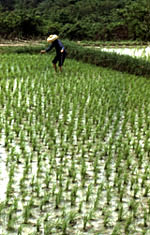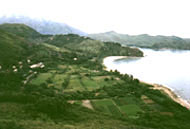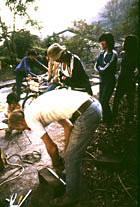
A traditional farming research and development project
by Keith Addison
Tai Long Wan village, Shek Pik, Lantau, Hong Kong, 1983-85
|
Stories by Keith Addison |
| Tai Long Wan -- Tales from a vanishing village Introduction |
|
Tea money |
|
Back to basics |
|
Forbidden fruit |
|
A place where nothing happens |
|
No sugar |
|
Treasure in a bowl of porridge |
|
Hong Kong and Southeast Asia -- Journalist follows his nose |
| Nutrient Starved Soils Lead To Nutrient Starved People |
|
Cecil Rajendra A Third World Poet and His Works |
|
Leave the farmers alone Bookreview of "Indigenous Agricultural Revolution -- Ecology and Food Production in West Africa", by Paul Richards |
|
A timeless art Some of the finest objects ever made |
|
Health hazards dog progress in electronics sector The dark side of electronics -- what happens to the health of workers on the production line |
|
Mo man tai ('No problem') -- "Write whatever you like" -- a weekly column in Hong Kong Life magazine Oct. 1994-Jan. 1996 |
|
Swag bag Death of a Toyota |
|
Zebra Crossing -- On the wrong side of South Africa's racial divide.
|
|
Curriculum Vitae |
|
|
In 1983, Keith Addison and artist-photographer Christine Thery rented an empty house in Tai Long Wan village from Fung Pak, the oldest man in the village.
 Weeding a rice field in Tai Long Wan |
In 1970 there were about 25,000 hectares of farmland growing rice in Hong Kong's rural areas; by 1983 there were only five hectares left, and two of them were in Tai Long Wan.
That's why we went there: this was one of the last intact examples of the old local traditional farming system. A great deal had changed in Guangdong Province in China where similar systems had been used, while Taiwanese and Southeast Asian traditional farmers used different versions of the basic Chinese farming system, and they'd also changed.
Tai Long Wan was a backwater -- the villagers all had their TV sets these days, but they'd had little to do with the modern world until the late 1960s. They were still living in the Ching Dynasty.
The farming system is rice-based, and in Tai Long Wan most of the bits and pieces of it were still in place, with a bit or a piece missing here and there, because it was winding down fast.
 Tai Long Wan valley |
In 1970 there were about 120 people living in Tai Long Wan. By 1983 there were only 22: most of the younger villagers had moved to the city, leaving a village of grandparents and a few grandchildren. The whole middle generation was missing.
Many Third World villages have this problem, along with the labour shortage that goes with it, or the opposite problem: too many people, and not enough work for them. In the one you count hands, in the other, mouths.
By then an increasing number of Third World development workers were suggesting the traditional Chinese farming system was a better model for agricultural development in Southeast Asia and elsewhere than modern industrialized farming methods were proving to be.
 One of the last rice harvests in Hong Kong |
We became increasingly interested in the Chinese model and in traditional farming systems in general as an alternative basis for development, and we had rather definite views on just what development meant, and what it didn't mean.
"Who benefits, and at whose expense?" we wanted to know. Don't always believe what they tell you in the city -- go and see for yourself.
This is what we knew of traditional farming:
Traditional farms may be "old-fashioned" but they can be highly productive, using methods which rely on locally available, renewable resources instead of expensive inputs from outside.
Traditional farming is usually well adapted to the local environment -- the traditional methods are sustainable.
Traditional farms tend to be small. Contrary to popular belief, studies from all over the world show that small farmers usually produce more per unit of land than large farmers do: one-third more in India, 60% more in Thailand, and three to 14 times more in Latin America, according to the World Bank (World Bank, The Assault on World Poverty -- Problems of Rural Development, Education, and Health, Johns Hopkins University Press, Baltimore, 1975).
 Keith studying the locals -- the sight of a foreign devil actually doing something was almost as good as TV |
Traditional systems are also flexible -- they can be adapted to a wide variety of local conditions, they make the most of local resources, they can absorb extra labour, or make do with not enough labour. Traditional vegetable farms in Hong Kong in the 1970s had 4.5 workers per hectare, in Thailand 3, in Malaysia 4.3, in the Philippines from 3 to 8, while brigade farms in South China used 21 workers per hectare.
So we went to Tai Long Wan to learn more.











